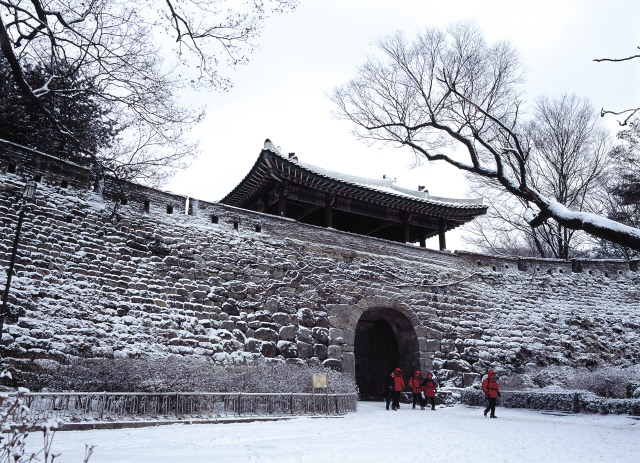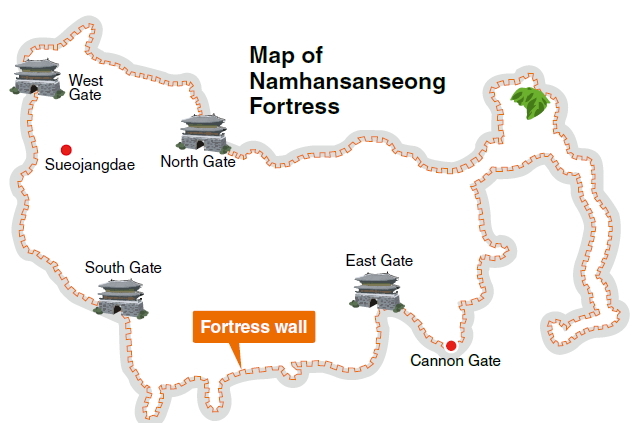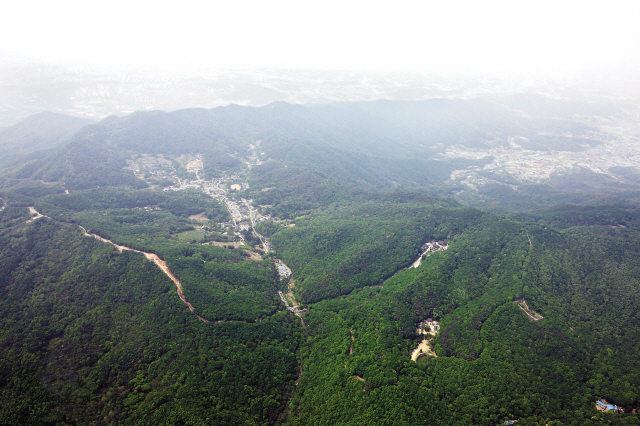Namhansanseong Fortress, a rare type of stronghold
Fortified stone wall, once king’s war refuge, anticipates designation as UNESCO World Heritage Site
By Lee Woo-youngPublished : Jan. 9, 2013 - 20:42
The ancient mountain fortress Namhansanseong, which served as a strategic defense facility at various times in Korea’s turbulent history, is one of the most frequently visited cultural heritage sites in the country today.
The fortress stands testimony of past conflicts from the seventh to 17th centuries, enduring foreign invasions big and small since the Unified Silla era.
Registered as National Historic Site No. 57, the fortress was included on the tentative list of UNESCO’s World Heritage Sites in 2010. The government is submitting nomination proposals for inclusion on the cultural heritage list on Jan. 31. The selection as a heritage site is scheduled to be announced in June 2014.
The fortress stands testimony of past conflicts from the seventh to 17th centuries, enduring foreign invasions big and small since the Unified Silla era.
Registered as National Historic Site No. 57, the fortress was included on the tentative list of UNESCO’s World Heritage Sites in 2010. The government is submitting nomination proposals for inclusion on the cultural heritage list on Jan. 31. The selection as a heritage site is scheduled to be announced in June 2014.


The 11.76-km fortress is located on Mt. Namhansan that spreads across three cities ― Gwangju, Seongnam and Hanam ― in Gyeonggi Province. Located on a rough mountain ridge, it served as a strategic stronghold from the Unified Silla era to the Joseon era.
Although initially built during the Unified Silla period, the fortress people see today dates back from the mid-Joseon period.
With multiple renovations and reconstructions at different time periods, the fortress reflects different architectural styles. It is also the point that meets the fourth criterion by UNESCO in its selection of World Heritage ― that a heritage site should “be an outstanding example of a type of building, architectural or technological ensemble or landscape.”
“The main wall was built upon the foundation used for the walls of Jujang Fortress during the Unified Silla period. The outer wall was built over time, and it shows a mixture of different construction techniques from Silla to Joseon,” wrote Kim Young-hak of Namhansanseong Culture and Tourism Initiative, the local government-funded public organization in charge of management and protection of the fortress.
Other experts note that it is a one-of-a-kind architectural heritage as there are not many fortresses in the world built on a steep mountain ridge and designed to serve as a temporary capital during war.
“It’s not easy to find a fortress as big as Namhansanseong built on a 500-meter rugged mountain and that has been managed over a long period of time,” wrote Lee Ki-bong, an expert of antique books at the National Library of Korea in his paper “The Value of Namhansanseong as a Multifaceted Fortress Reflecting the History of Korea and a UNESCO World Heritage.”

Namhansanseong Fortress is also noted as a rare case of a mountain fortress built to serve as a temporary capital of a country as well as a strategic defense point.
Namhansanseong Fortress is also the only mountain fortress with a a royal palace complex and a large village.
“It is a large fortress with the king’s temporary residence and a village with more than 3,000 people,” said Jeon Jong-deok, director of the NCTI, who added that there were not many towns with 3,000 residents during the Joseon era.
Now the fortress and the village have become a must-see tourist destination in Korea with an average of 3 million visitors a year.
The royal residence called Haenggung, along with a royal ancestral shrine called Jongmyo and an altar for the land and grain god Sajik served the administrative role of the fortress.
During the second invasion of the Manchus in 1636-1637, King Injo of Joseon conducted administrative and military affairs with sufficient resources and infrastructure within the fortress. He stayed for 47 days until he surrendered to the Qing Emperor Taizong.
Namhansanseong Fortress also served as a base of the anti-Japanese citizen army in 1907, as well as the famous March 1 Independence Movement in 1919 against the Japanese colonization.
“We think Namhansanseong Fortress holds historical and cultural significance as a UNESCO World Heritage in its unique historical and architectural values,” stressed Jeon.
By Lee Woo-young (wylee@heraldcorp.com)





![[Herald Interview] 'Amid aging population, Korea to invite more young professionals from overseas'](http://res.heraldm.com/phpwas/restmb_idxmake.php?idx=644&simg=/content/image/2024/04/24/20240424050844_0.jpg&u=20240424200058)











![[KH Explains] Korean shipbuilding stocks rally: Real growth or bubble?](http://res.heraldm.com/phpwas/restmb_idxmake.php?idx=652&simg=/content/image/2024/04/25/20240425050656_0.jpg&u=)

